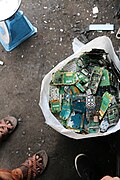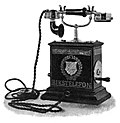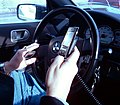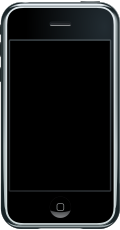Jesse Ventura

A telephone, colloquially referred to as a phone, is a telecommunications device that enables two or more users to conduct a conversation when they are too far apart to be easily heard directly. A telephone converts sound, typically and most efficiently the human voice, into electronic signals that are transmitted via cables and other communication channels to another telephone which reproduces the sound to the receiving user. The term is derived from Ancient Greek: τῆλε, romanized: tēle, lit. 'far' and φωνή (phōnē, voice), together meaning distant voice.
In 1876, Alexander Graham Bell was the first to be granted a United States patent for a device that produced clearly intelligible replication of the human voice at a second device. This instrument was further developed by many others, and became rapidly indispensable in business, government, and in households. (Full article...)

A mobile phone or cell phone is a portable telephone that allows users to make and receive calls over a radio frequency link while moving within a designated telephone service area, unlike fixed-location phones (landline phones). This radio frequency link connects to the switching systems of a mobile phone operator, providing access to the public switched telephone network (PSTN). Modern mobile telephony relies on a cellular network architecture, which is why mobile phones are often referred to as 'cell phones' in North America. (Full article...)
A smartphone is a mobile phone with advanced computing capabilities. It typically has a touchscreen interface, allowing users to access a wide range of applications and services, such as web browsing, email, and social media, as well as multimedia playback and streaming. Smartphones have built-in cameras, GPS navigation, and support for various communication methods, including voice calls, text messaging, and internet-based messaging apps. Smartphones are distinguished from older-design feature phones by their more advanced hardware capabilities and extensive mobile operating systems, access to the internet, business applications, mobile payments, and multimedia functionality, including music, video, gaming, radio, and television. (Full article...)
Selected article -

The red telephone box is a telephone kiosk for a public telephone designed by Sir Giles Gilbert Scott, the architect responsible for Liverpool Cathedral.
The telephone box is a familiar sight on the streets of the United Kingdom, its associated Crown Dependencies, the British Overseas Territories and Malta. Despite a reduction in their numbers in recent years, the traditional British red telephone kiosk can still be seen in many places throughout the UK, and in overseas territories, the Commonwealth and elsewhere around the world. The colour red was chosen to make them easy to spot.
From 1926 onwards, the fascias of the kiosks were emblazoned with a prominent crown, representing the British Government. The red phone box is often seen as a British cultural icon throughout the world. In 2006, the K2 telephone box was voted one of Britain's top 10 design icons, which included the Mini, Supermarine Spitfire, London tube map, World Wide Web, Concorde and the AEC Routemaster bus. In 2009, the K2 was selected by the Royal Mail for their "British Design Classics" commemorative postage stamp issue. (Full article...)
Types of phones -

Mobile radio telephone systems were mobile telephony systems that preceded modern cellular network technology. Since they were the predecessors of the first generation of cellular telephones, these systems are sometimes retroactively referred to as pre-cellular (or sometimes zero generation, that is, 0G) systems. Technologies used in pre-cellular systems included the Push-to-talk (PTT or manual), Mobile Telephone Service (MTS), Improved Mobile Telephone Service (IMTS), and Advanced Mobile Telephone System (AMTS) systems. These early mobile telephone systems can be distinguished from earlier closed radiotelephone systems in that they were available as a commercial service that was part of the public switched telephone network, with their own telephone numbers, rather than part of a closed network such as a police radio or taxi dispatching system.
These mobile telephones were usually mounted in cars or trucks (thus called car phones), although portable briefcase models were also made. Typically, the transceiver (transmitter-receiver) was mounted in the vehicle trunk and attached to the "head" (dial, display, and handset) mounted near the driver seat. They were sold through WCCs (Wireline Common Carriers, a.k.a. telephone companies), RCCs (Radio Common Carriers), and two-way radio dealers. (Full article...)
Selected audio -
Last-call return, automatic recall, or (on PBX and centrex service) camp-on, is a telecommunication feature offered by telephony service providers to subscribers to provide the subscriber with the telephone number, and sometimes the time, of the last caller. The service may also offer the facility to place a call to the calling party. (Full article...)
List articles

- Comparison of smartphones
- List of best-selling mobile phones
- List of countries by number of broadband Internet subscriptions
- List of countries by number of telephone lines in use
- List of countries by smartphone penetration
- List of country calling codes
- List of iPhone models
- List of mobile network operators
- List of mobile phone brands by country
- List of mobile phone generations
- List of telecommunications companies
Related portals
General images -
Selected biography
Martin Cooper (born December 26, 1928) is an American engineer. He is a pioneer in the wireless communications industry, especially in radio spectrum management, with eleven patents in the field.
On April 3, 1973, Cooper placed the first public call from a handheld portable cell phone while working at Motorola, from a Manhattan sidewalk to his counterpart at competitor Bell Labs. Cooper reprised the first handheld cellular mobile phone (distinct from the car phone) in 1973 and led the team that redeveloped it and brought it to market in 1983. He is considered the "father of the (handheld) cell phone", and received the 2015 IEEE Masaru Ibuka Consumer Electronics Award for this work.
Cooper is co-founder of numerous communications companies with his wife and business partner Arlene Harris; He is co-founder and current Chairman of Dyna LLC, in Del Mar, California. Cooper also sits on committees supporting the U.S. Federal Communications Commission and the United States Department of Commerce. (Full article...)
Selected images
Topics
Subcategories

More
 |
Here are some tasks awaiting attention:
|
Telephones in the news
No recent news
Associated Wikimedia
The following Wikimedia Foundation sister projects provide more on this subject:
-
 Commons
Commons
Free media repository -
 Wikibooks
Wikibooks
Free textbooks and manuals -
 Wikidata
Wikidata
Free knowledge base -
 Wikinews
Wikinews
Free-content news -
 Wikiquote
Wikiquote
Collection of quotations -
 Wikisource
Wikisource
Free-content library -
 Wikiversity
Wikiversity
Free learning tools -
 Wiktionary
Wiktionary
Dictionary and thesaurus
-

-

-

-

-
Random portal

 Read
Read
 AUTHORPÆDIA is hosted by Authorpædia Foundation, Inc. a U.S. non-profit organization.
AUTHORPÆDIA is hosted by Authorpædia Foundation, Inc. a U.S. non-profit organization.



































































































